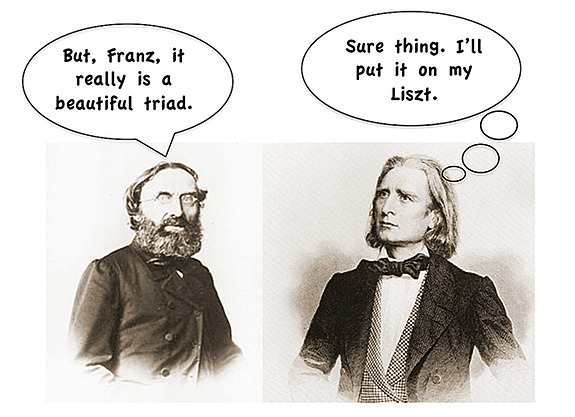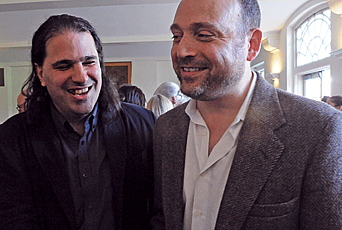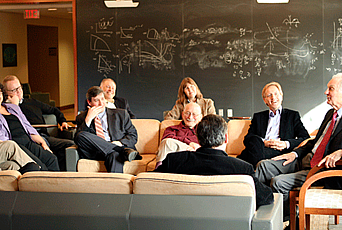Music Theory’s Monstrous Chord

On the second Sunday after Trinity in 1724, the congregation at the Thomaskirche in Leipzig heard Johann Sebastian Bach’s new cantata that began with the words Ach Gott. Bach set the word Gott to the most dissonant triad known at the time: the augmented triad. Bach’s own son, Carl Philipp Emanuel Bach, wrote in the second volume of his treatise of 1762 that the offending augmented fifth of this harmony requires careful preparation. His father did not prepare it at all. Acclimatized as we are today to all kinds of dissonances, this harmony might pass the modern listener by. But it would have disconcerted the ears of the eighteenth-century congregation, giving them a God-fearing shudder, while setting the scene for the biblical message of the day. Bach, after all, was setting the tune and words, Ach Gott, vom Himmel sieh darein, that Martin Luther had penned exactly two hundred years earlier, in 1524. Based on Psalm 12, Luther tells of a perilous world filled with those who shun God.
The augmented triad has long been a headache for music theorists, only partially on the basis of its harsh sound. Mostly they are perturbed by its construction and their inability to pinpoint a convincing origin for it. It would be no exaggeration to say that, just two years before Bach composed his cantata, the harmonic theory of Jean-Philippe Rameau, a towering figure in the history of music theory, brought about a paradigm shift in how chords were categorized and understood to have been constructed. Although much of Rameau’s theory still holds sway today, a now defunct aspect of his Traité de l’harmonie led him to deem the augmented triad “worthless.” It belonged to the rubbish heap of potential chords because it did not contain the right kind of fifth, and therefore it must be an incomplete chord. According to Rameau’s newly minted theory, all valid, complete chords must contain a perfect fifth; the augmented triad gets its name from the fact that its fifth is “augmented” (it is a semitone larger than the perfect fifth).
Rameau salvaged the triad by adding two more notes to it, turning it into a five-note harmony. Now completed to his satisfaction, the sonority corresponded to one he had undoubtedly heard before, for in this guise it is prevalent in the music of French composers in the generation before Bach: Couperin and Charpentier were especially keen on it. In this context, Bach’s use of the sonority—without the camouflage of the extra two tones—is all the more striking.
It was not until 1853 that the augmented triad—as a three-note entity—would come to be treasured by music theorists for its construction. Thanks to the invention of equal temperament (our modern tuning system), the theorist Carl Friedrich Weitzmann was able to see in this triad a beautifully symmetrical construction. It divides the octave into three equal segments and has the rare property of inverting into itself. In his view, it had been unfairly maligned by his closest predecessors as “monstrous” and as a chord that “screams its shrill sound at us.”
In part, Weitzmann’s attention was drawn to the triad due to a theoretical blunder that took place at the turn of the nineteenth century, a blunder that had everything to do with a misstep in theorists’ quest for another kind of symmetry. One of the primary ambitions since the mid-eighteenth century had been to explain the two modes of the tonal system—major and minor—through an identical set of principles. I shall therefore now turn to a brief history of this quest, illustrating how it shaped the design of the fundamentals of music theory. We shall see how this blunder came about in 1817 and how it gave the augmented triad an unexpected new lease of life.
When the major and minor modes emerged from the church modes at the dawn of modern tonality (arguably ca. 1600), the major mode quickly developed into a stable shape. It was represented by a single scale and therefore the identity of its harmonies, which are made up of various combinations of notes from the scale, was crystal clear. By contrast, the minor mode was unstable: there are no fewer than three versions of the minor scale, known as the “natural,” “harmonic,” and “melodic” scales, each of which suggests that a different set of harmonies are intrinsic—or “diatonic,” to use the technical term—to the minor mode. While the first five notes are identical in all three versions of the minor scale, the next two notes proceed in various patterns. In the case of the “melodic” minor scale its pattern even differs when the notes are played on the way up versus on the way down.
There thus arose a fundamental inequality between the two modes: while major had one scale, minor had three; while major had few diatonic harmonies, minor had many. Instead of relishing the differences between the modes (as composers seemed to do), theorists tried to iron them out, in what turned out to be an ever-elusive quest for symmetry.
The habit amongst theorists was generally to acknowledge all three versions of minor, but to pick one as foundational in an attempt to replicate the basic condition of the major mode. The choice is mostly determined by what century a theorist was writing in. The eighteenth century witnessed a preference for the natural minor. It is the only version of minor not to contain the augmented triad, which meant theorists could easily navigate around it. Most simply repeated Rameau’s view of it. At the turn of the nineteenth century, theorists switched to the harmonic minor, and for the first time had to confront the possibility that the augmented triad might be a fundamental harmony.
A number of cardinal theoretical ideas—still cherished today—would not have been possible without the eighteenth-century preference for the natural minor. For instance, the notion developed that all twenty-four major and minor keys would be organized into pairs of twelve keys that share the same key signature. This idea also lies at the heart of the development of music theory’s most iconic diagram, the circle of fifths—a diagram still used today to teach key signatures. The theory of key signatures could so easily have gone differently. Take, for example, C major, which is made up of the pitches C D E F G A B C. Its relative minor pair is A minor, which in its natural minor incarnation contains the same pitches but starting from a different point: A B C D E F G A. These two therefore share the same key signature of no sharps or flats. By contrast, the pitches of A harmonic minor are: A B C D E F G# A, which would have necessitated the signature of one sharp, G#. This signature is certainly theoretically possible—and was mooted in the nineteenth century—but it never caught on.
Although the natural minor clearly led to important theoretical ideas, it lacked the capacity to reflect musical practice in one crucial respect. In theory, its three primary harmonies are all minor; in composition, one of those primary harmonies—known as the dominant—is invariably major. This dominant is especially critical to cadences, which are the musical equivalent to commas and full stops that punctuate sentences. To obtain this all-important harmony, eighteenth-century theorists either cherry-picked it from the harmonic minor scale or, more commonly, they argued that it was borrowed from the major mode.
At the beginning of the nineteenth century, theorists began to argue that this dominant major harmony was so prevalent in minor-mode music that it needed to be shown to be diatonic, rather than borrowed from elsewhere. They therefore turned to the harmonic minor as their new foundational scale. While gaining the dominant was a triumph, lurking on the third degree of the scale was none other than the augmented triad. With the precedent set in the eighteenth century that fundamental harmonies are defined as those harmonies that are made up of notes from the scale, the augmented triad seemed poised to become a fundamental harmony.
Numerous early nineteenth-century theorists welcomed the new role for the harmonic minor scale, but few were ready to embrace the augmented triad. In 1817, Gottfried Weber, a lawyer by trade and an avid musician, critic, and theorist in his spare time, came up with an astonishing solution, a solution that would dominate the theoretical landscape for over half a century and change the way that hitherto staple harmonies of the tonal system were heard. Instead of presenting the augmented triad in his showcase diagram of the fundamental chords, Weber put a rest in its place. Perceiving the chord as “monstrous,” he not only eliminated it from view, but the musical rest—the notational symbol for silence—ensured that nothing reached the ears either. This absence was no accident, for throughout Weber’s multi-volumed treatise published over five years, there are numerous other blanks in dozens of other tables and chasms in his theoretical examples of chord progressions wherever this “monstrous” chord ought otherwise to have appeared.
Weber is especially famous for inviting composers to open their minds to all possible combinations of fundamental chords in all twenty-four keys. He calculated a staggering 6888 possibilities, but the real surprise—at least for me, as a historian of music theory—is that, if the rest (and his three other equally curious missing chords) were filled in, the number would have been 9380. To compensate for these absences, he had to develop a new—and strange—theory of modulation and harmonic perception. Weber thus had plenty of opportunity to witness the limiting effects of his rest—indeed his blunder. Yet he tenaciously held to his theory.
Did anyone else hear music this way? The short answer is yes. A litany of theorists followed suit and at least one aesthetician defined “the beautiful” in music through Weber. Fascinating as it would be to trace that history, my story resumes with Weitzmann, who rescued the augmented triad in 1853.
Weitzmann wrote a whole treatise on the triad, observing that it “has been previously considered by all theorists and practical musicians to be a sinister guest, whom they believed they must get rid of as soon as possible. Its questionable heritage aroused suspicion; its harsh manner and apparent awkwardness were not suited to winning it friends. . . . [It deserves] to be granted a permanent place in the kingdom of tones.”
He found a new origin for it. If the major and minor triads are inverted around an axis of symmetry, say the pitch E, then the augmented triad can be shown to lie at the center of the tonal system: A C E G# B. Clever, but dubious. Nonetheless, Weitzmann’s lasting contribution is that he recognized the triad’s symmetrical properties and its capacity to elicit new tonal adventures. He came up with thirty-two ways to resolve the chord, whereas his predecessors had only ever mustered up one or two. He sent his treatise to his friend Franz Liszt, who promptly made use of its principles, and his music became littered with augmented triads in guises first explained theoretically by Weitzmann.
Until recently, Weitzmann was all but forgotten. Yet clearly his impact on music was profound and unprecedented: the old adage is that theory lags behind practice. However, in his day, he was also lauded for his ability to explain practice. Weitzmann responded to a competition for the best explanation of the compositional techniques of the so-called New German School, of which Liszt and Wagner were considered members. To be sure, Weitzmann’s resultant, expanded treatise, Harmoniesystem (1860), is a good read, but it is perhaps no surprise that he won, since it was his theory that had infused fresh creative energy into the harmonic language of the New German School in the first place. A sneaky win.
But Weitzmann’s impact did not end there. The kind of theoretical appreciation for the symmetry of the augmented triad spawned a kind of theoretical thinking that lies at the heart of a branch of mathematical music theory that is all the rage in academia today.


